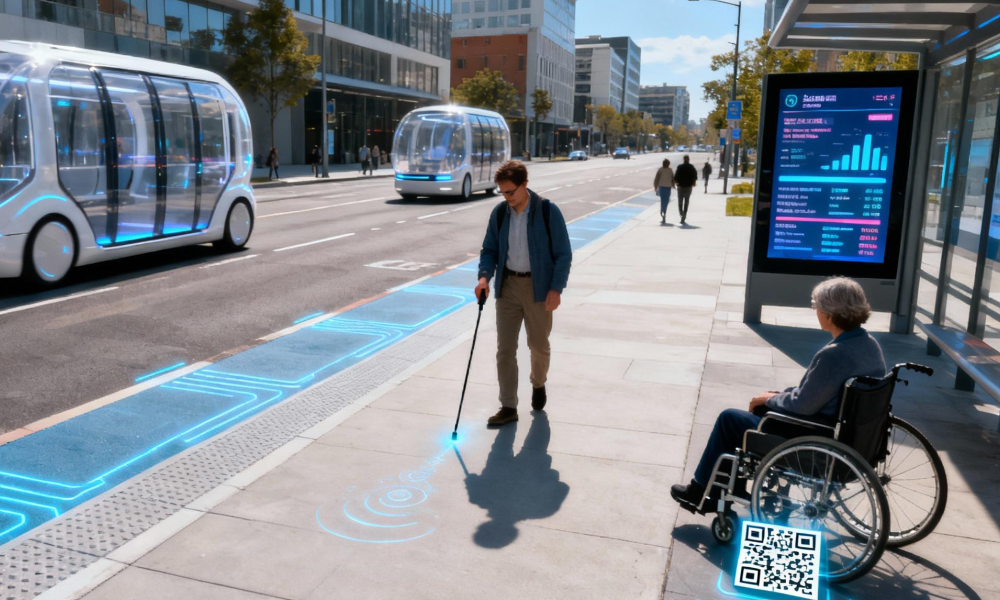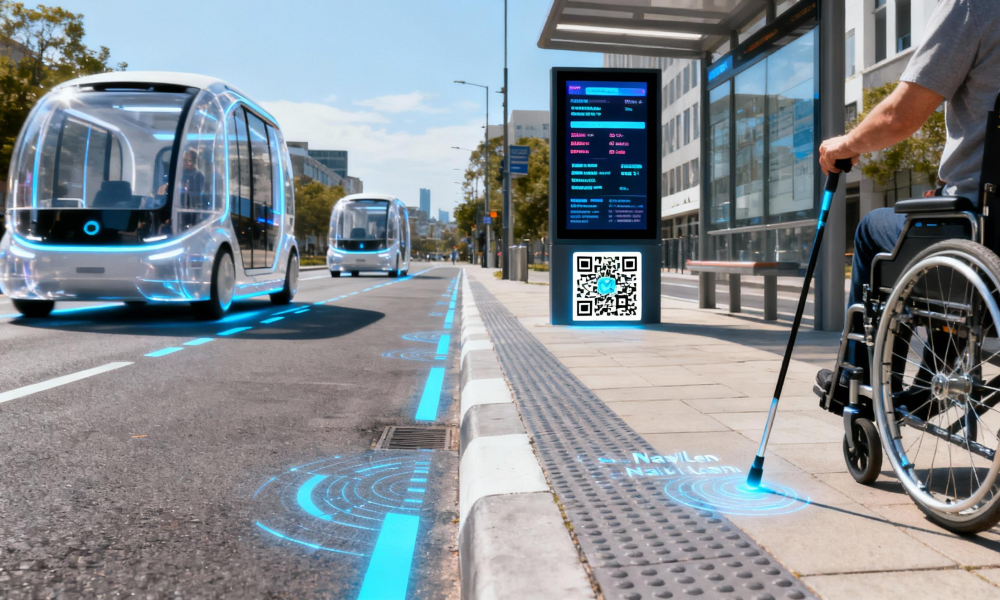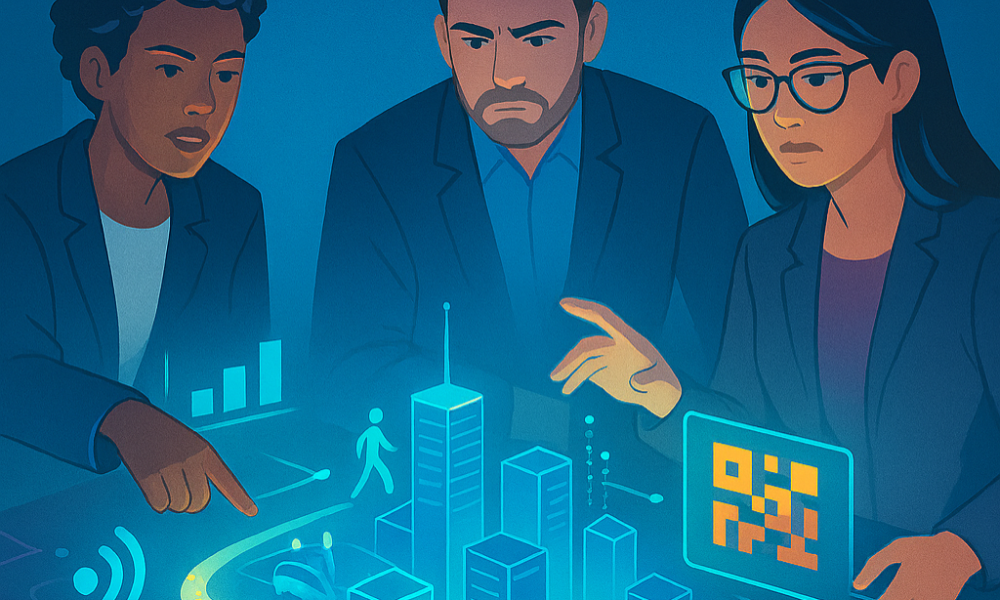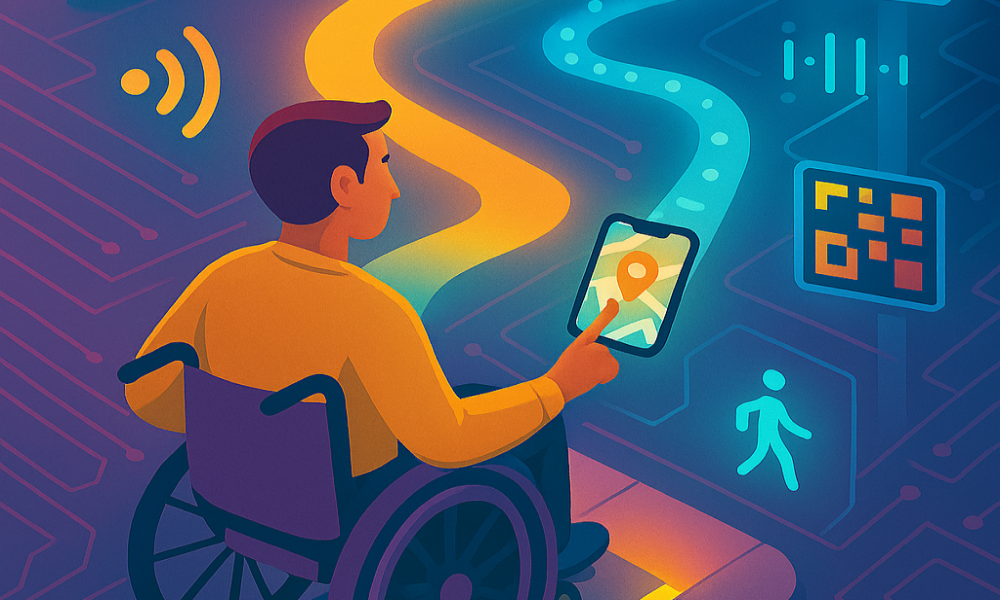
For decades, urban streets and public transport have presented significant, often prohibitive, barriers for individuals with mobility and sensory impairments. While infrastructure improvements have addressed some of these challenges, Intelligent Transport Systems (ITS) are poised to deliver the next revolution in accessibility. By moving beyond a one-size-fits-all approach, emerging technologies are enabling a future where mobility is personalised, seamless and inclusive for everyone.
Navigating a complex urban environment can be overwhelming for people with visual impairments. Traditional wayfinding tools, like simple white canes, are limited, but smart technology is changing the game.
The integration of technology features into canes, such as ultrasonic sensors and Bluetooth connectivity can provide real-time feedback to users that enhances their perception of their environment beyond the surface in front of them, including head-level obstacles, such as overhanging branches or signs. They can also connect to a smartphone app to provide voice alerts for pedestrian crossings, bus and train times, freeing the user from juggling a separate device.

Phone apps powered by AI can use a phone's internal sensors to provide highly precise, step-by-step guidance, even in environments without GPS like underground stations. Similarly, apps such as Google Lookout employ computer vision to audibly describe visual information, helping users interpret their surroundings and read signs.
For location identification, companies are developing systems like NaviLens, which uses specialised QR codes that can be read from a distance by a smartphone camera. The app translates the code into audio information about the user's location, helping them find bus stops or platform edges.
Integrating digital intelligence into city infrastructure is creating a more responsive and navigable streetscape for people with mobility challenges.
Sensors and AI at crossings can detect when a pedestrian is preparing to cross and dynamically adjust the signal time to provide extra crossing time for those who need it. This offers a more flexible and safer solution than fixed timings that may not accommodate all needs.
Real-time virtual replicas of city environments, known as digital twins, allow urban planners to simulate and test accessibility scenarios before a project is built. This helps ensure new developments, from housing estates to transport hubs, are designed for inclusivity from the outset, rather than requiring expensive retrofitting later.
Bluetooth beacons, wall cameras and AI-updated maps are enabling indoor navigation systems that help users locate specific points within large, complex spaces like airports and train stations. This is particularly valuable for navigating to lifts, accessible ramps and specific platforms.
The public transport experience is also being transformed by personalised, data-driven technologies and innovations in vehicle design.
Personalised passenger assistance apps allow travellers with mobility impairments to request assistance in advance. This streamlines communication with staff and provides reassurance that their specific needs will be met, helping to build confidence in using public transport.
Automated self-driving vehicles have the potential to deliver unparalleled independence for people with disabilities. Trials with wheelchair-accessible Automated Vehicles (AV) show how AI-based booking and routing can match shuttles to passengers, offering greater travel freedom. It is critical, however, that accessibility remains a central consideration throughout the development of AV technology, not only the physical design but also the interfaces to interact with them.
The Mobility-as-a-Service (MaaS) model, powered by AI, can now deliver hyper-personalised travel experiences. By integrating data on journey planning, users can receive information about wheelchair-accessible routes, quiet carriages for those on the autism spectrum and step-free access options.

Technology's power is fully realised only when its application considers the diverse capabilities and limitations of human users. This is the central tenet of human factors and inclusive design, an approach that moves beyond minimum legal requirements to create genuinely usable environments for all.
The design of thoughtful streetscapes benefits all users, resulting in useable and aesthetically pleasing placemaking. In practice, this means street furniture should be strategically placed to provide convenient resting points without creating hazards or obstructions for people with visual or mobility impairments. It involves using high-contrast, non-slip paving with tactile features at crossings, making it easier for people with low vision to navigate safely. Human factors analysis can prevent common problems, such as pedestrian crossings which are difficult or daunting to use because of poorly thought-out geometric designs, by assessing the real-world impact on users with different needs.
For equipment, such as ticketing kiosks or intercoms, human factors ensures they are intuitive and operable by everyone. This can include features like screen readers, adjustable-height interfaces for wheelchair users and large-print, high-contrast displays. In public transport, it means designing seating with varied heights and armrests to aid people with limited mobility, as well as providing clear, audible and visual announcements on trains and at stations.
The benefits of inclusive design often extend beyond the target users, in what is known as the "kerb cut effect". For instance, dropped kerbs, originally for wheelchair users, are now indispensable for parents with buggies, travellers with luggage and delivery drivers. By prioritising accessibility, cities can create a safer, more convenient environment for everyone.

While accessible streets and vehicles are vital, a truly inclusive transport system requires seamless transitions between different modes of transport. Intermodal links, such as interchanges between bus, train and metro, are often points of friction, confusion and anxiety for disabled travellers. Intelligently designed, technology-driven intermodal connections are essential to alleviate these barriers.
By using ITS, passengers can receive real-time information about connecting services through a single app or digital interface. A bus delay, for example, can be automatically factored into a rail journey plan and the system can even suggest an alternative tube line to minimise wait times and stress. This contrasts with the current siloed information from different transport operators, which leaves travellers with little recourse when plans are disrupted.
Technology can make interchange hubs easier to navigate. Digital screens with high-contrast text and integrated sign language translations, can provide clear directional information. In conjunction with indoor positioning technology, visually or mobility-impaired passengers can be guided from one platform to another via the most accessible route, avoiding stairs and other obstacles.
Data from passengers, collected via assistive apps, can allow transport operators to intelligently manage crowds and provide assistance. If a passenger requests wheelchair assistance in advance for a connecting train, the intelligent system can ensure staff are pre-notified and positioned at the correct location, avoiding the need for passengers to navigate a large station to find help. In the future, automated accessibility features could be triggered, such as a ramp deploying at the correct moment as the vehicle pulls into the station.
While the technological potential is vast, successful implementation depends on a human-centric approach. Collaboration between developers, transport operators, policymakers and people with lived experience of disability is vital to ensure these tools meet real-world needs.
Investing in accessibility is not just a social imperative, it's an economic opportunity. With the spending power of disabled consumers representing a significant market, prioritising inclusive technology makes both good business and social sense. As the ITS sector continues to evolve, embracing these innovations will be key to creating a truly accessible, equitable and efficient urban transport system for all.